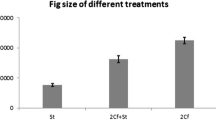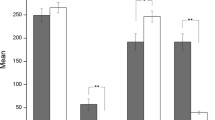Abstract
The reproductive strategies of Walkerella sp.1 associated with Ficus curtipes and Walkerella sp.2 associated with Ficus benjamina were investigated. Both species oviposited from outside the fig wall. Walkerella sp.1 was the first non-pollinating fig to oviposit on Ficus curtipes and began to do this ten days after figs syconia began to develop. The larvae of Walkerella sp.1 were only found in the most external ovary layer of the fig. Walkerella sp.2 starts ovipositing after several other non-pollinating fig wasps have already laid their eggs in F. benjamina. The progeny of Walkerella sp.2 are distributed in the external ovary layer, the middle ovary layer, and/or the inner ovary layer of the figs. However, more than a quarter of the offspring were found in the most external layer and only a few in the inner layer. Experimental studies proved that the two Walkerella species are gall formers. In both manipulated figs and in natural figs, the sex ratios of Walkerella sp.1 and Walkerella sp.2 were female-biased. In Walkerella sp.2, the overall sex ratio increased with the proportion of figs parasitized in a crop, but this was not the case for Walkerella sp.1. Females of both Walkerella species appear not to have information about the patches on which they oviposit because sex ratios of both species decreased as brood sizes within individual figs increased and foundresses of both species were able to lay clutches containing a single male egg and several female eggs.

Similar content being viewed by others
References
Bai LF, Yang DR, Compton SG (2008) A gall midge inhabiting the figs of Ficus benjamina in Xishuangbanna, south-western China. Symbiosis 45:149–152
Bronstein JL (1991) The non-pollinating wasp fauna of Ficus pertusa: exploitation of a mutualism. Oikos 61:175–186
Compton SG, van Noort S (1992) Southern African fig wasp assemblages: host relationships and resource utilization. Proc K Ned Akad Wet 95:423–435
Cook JM, Power SA (1996) Effects of within-tree flowering asynchrony on the dynamics of seed and wasp production in an Australian fig species. J Biogeogr 23:487–493
Cook JM, Compton SG, Herre EA, West SA (1997) Alternative mating tactics and extreme male dimorphism in fig wasps. Proc R Soc Lond B 264:747–754
Douglas AE (2010) The symbiotic habit. Princeton University Press, Princeton
Elias LG, Menezes AO Jr, Pereira RAS (2008) Colonization sequence of non-pollinating fig wasps associated with Ficus citrifolia in Brazil. Symbiosis 45:107–111
Fellowes MDE, Compton SG, Cook JM (1999) Sex allocation and local mate competition in Old World non-pollinating fig wasps. Behav Ecol Sociobiol 46:95–102
Galil J (1977) Fig biology. Endeavour 1:52–56
Greeff JM (1997) Offspring allocation in externally ovipositing fig wasps with varying clutch size and sex ratio. Behav Ecol 8:500–505
Hamilton WD (1967) Extraordinary sex ratios. Science 156:477–488
Hardy ICW, Mayhew PJ (1998) Partial local mating and the sex ratio: indirect comparative evidence. Trends Ecol Evol 11:431–432
Hawkins BA, Compton SG (1992) African fig wasp communities-undersaturation and latitudinal gradients in species richness. J Anim Ecol 61:361–372
Herre EA (1985) Sex ratio adjustment in fig wasps. Science 228:896–898
Herre EA (1987) Optimality, plasticity, and selective regime in fig wasp sex ratios. Nature 329:627–629
Jousselin E, van Noort S, Rasplus JY, Greeff JM (2006) Patterns of diversification of Afrotropical Otiteselline fig wasps: phylogenetic study reveals a double radiation across host figs and conservatism of host association. J Evol Biol 19:253–266
Jousselin E, van Noort S, Berry V, Rasplus JY, Rønsted N, Erasmus C, Greeff JM (2008) One fig to bind them all: host conservatism in a fig wasp community unravelled by cospeciation analyses among pollinating and non-pollinating fig wasps. Evolution 62:1777–1797
Kerdelhué C, Rasplus JY (1996) Non-pollinating Afrotropical fig wasps affect the fig-pollinator mutualism in Ficus within the subgenus Sycomorus. Oikos 75:3–14
Kerdelhué C, Rossi JP, Rasplus JY (2000) Comparative community ecology studies on Old World figs and fig wasps. Ecology 81:2832–2849
Moore CJ, Pienaar J, Greeff JM (2004) Male morphological variation and the determinants of body size in two Otiteselline fig wasps. Behav Ecol 15:735–741
Peng YQ, Yang DR, Wang QY (2005a) Quantitative tests of interaction between pollinating and non-pollinating fig wasps on dioecious Ficus hispida. Ecol Entomol 30:70–77
Peng YQ, Yang DR, Duan ZB (2005b) The population dynamics of a non-pollinating fig wasp on Ficus auriculata at Xishuangbanna, China. J Trop Ecol 21:581–584
Pienaar J, Greeff JM (2003) Maternal control of sex and male morphology in the Otitesella fig wasps. J Evol Biol 16:244–253
Pienaar J, Greeff JM (2006) Adaptive non-Fisherian sex ratios in a patchilydistributed population with outbreeding. Evol Ecol 20:431–445
Raja S, Suleman N, Compton SG, Moore JC (2008) The mechanism of sex ratio adjustment in a pollinating fig wasp. Proc R Soc Lond B 275:1603–1610
West SA, Herre EA (1994) The ecology of the New World fig-parasitizing wasps Idarnes and implications for the evolution of the fig-pollinator mutualism. Proc R Soc Lond B 258:67–72
West SA, Herre EA, Windsor DM, Green PRS (1996) The ecology and evolution of the New World non-pollinating fig wasp communities. J Biogeogr 23:447–458
West SA, Herre EA (1998) Partial local mate competition and the sex ratio: a study on non-pollinating fig wasps. J Evol Biol 11:531–548
Wiebes JT (1979) Co-evolution of figs and their insect pollinators. Annu Rev Ecol Syst 10:1–12
Yu DW (2001) Parasites of mutualisms. Biol J Linn Soc 72:529–546
Zhang FP, Yang DR (2009) Study on mating ecology and sex ratio of three internally ovipositing fig wasps of Ficus curetipes. Bull Entomol Res 14:1–5
Zhen WQ, Huang DW, Xiao JH, Yang DR, Zhu CD, Xiao H (2005) Ovipositor length of three Apocrypta species: effect on oviposition behavior and correlation with syconial thickness. Phytoparasitica 33:113–120
Acknowledgements
We are grateful to Gang Wang, Pei Yang, Yuan Zhang, Wen Juan Ma, and Yi Cui Xi for assistance. We thank J.M. Greeff and the anonymous reviewer for their valuable comments on our manuscript. We also thank Professor David H.S. Richardson for his help in improving the grammar and English of this paper. This study was funded by Chinese Natural Science foundation (30970403, 30970439).
Author information
Authors and Affiliations
Corresponding author
Rights and permissions
About this article
Cite this article
Wang, ZJ., Zhang, FP., Peng, YQ. et al. Comparison of reproductive strategies in two externally ovipositing non-pollinating fig wasps. Symbiosis 51, 181–186 (2010). https://doi.org/10.1007/s13199-010-0072-4
Received:
Accepted:
Published:
Issue Date:
DOI: https://doi.org/10.1007/s13199-010-0072-4




